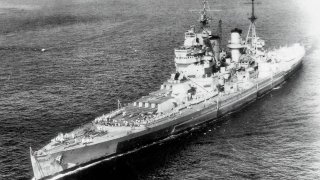Ranked: The Royal Navy's 4 Best and Baddest Battleships of World War II
During World War II, Britain's battleships symbolized its waning naval dominance. Key vessels included the HMS King George V, which played a crucial role in sinking Germany's Bismarck, and the HMS Rodney, another Bismarck pursuer.
Summary and Key Points: During World War II, Britain's battleships symbolized its waning naval dominance. Key vessels included the HMS King George V, which played a crucial role in sinking Germany's Bismarck, and the HMS Rodney, another Bismarck pursuer.

-The HMS Howe showcased British involvement in the Pacific, assisting U.S. operations at Okinawa, while the HMS Anson endured Arctic convoys and helped liberate Hong Kong.
-These battleships, representing the twilight of British naval supremacy and the battleship era, were decommissioned post-war, marking the end of an era.
HMS King George V to HMS Anson: Britain's Last Battleships of WWII
The British once ruled the oceans, relying upon their imposing navy to manage a colonial empire. British dominance of the waterways allowed the island nation to become a global power with far-reaching territorial claims.
But by the time Germany initiated the Second World War, Britain’s status as the world’s most powerful nation, with the world’s most powerful navy, was slipping. By the end of that conflict the British, despite winning alongside the Allies, had been eclipsed. In the eight decades since, the UK never regained its footing as a top-tier power.

The final years of the British Royal Navy’s global dominance happen to coincide with the last years of the battleship’s primacy as the world’s most important naval vessel. Here are the United Kingdom’s most important battleships of World War II.
HMS King George V
The namesake of her class, the HMS King George V is important through its relationship to another, more famous battleship – the German Bismarck. The Bismarck is arguably the most famous battleship of all time and was brand new when it was pursued and fatally damaged at the hands of the King George V. Of course, the King George V deserves credit of her own accord. The 745-foot vessel was large and sophisticated for her era and served with distinction throughout the Second World War.
King George V was present in Tokyo Bay at the surrender ceremonies to end the war. The ship was mothballed in 1950, symbolizing in effect the post-war relegation of the United Kingdom to a secondary power.
HMS Rodney
The HMS Rodney makes the list for the same reason as the King George V; it helped to pursue and destroy the Bismarck. Unlike the King George V, however, the Rodney was a Nelson-class battleship built in the mid-1920s.
The Rodney was designed under the limitations of the Washington Naval Treaty, meaning her displacement could not exceed 35,000 tons. Accordingly, the vessel was relatively small and deficient.
Like the King George V, the Rodney was more than just her interactions with the Bismarck. The battleship saw heavy action throughout the Second World War. In fact, once the war was over, the Rodney had been used so heavily that she was relegated to the reserves. Ultimately, the 710-foot-long vessel was sold for scrap.
HMS Howe
The HMS Howe makes the list for her cosmopolitan career in the east and the west. In 1944, she became the first British battleship deployed to the east since 1941. The Royal Navy is not widely associated with actions in the Pacific during World War II, but the British did contribute to efforts against Imperial Japan. The Howe specifically assisted U.S. landings at Okinawa – and was even the target of kamikaze attacks. The Howe provided air defense while also firing on land-based targets. All of this came after assisting in the Allied operations in Europe.
Before the war was over, Howe made port stops in Sydney and Auckland. The Howe was relegated to the reserves in 1951 and sold for scrap in 1957 – with the exception of her bell, which was gifted to the St. Giles’ Cathedral in Edinburgh, Scotland.
HMS Anson
The HMS Anson is a King George V-class battleship that served in important yet less-remembered roles. For example, the battleship escorted Russian convoys in the Arctic. Northern supply routes were notorious for their stormy seas and sub-zero temperatures. The Anson escorted nine convoys through such conditions.
After the war, the Anson participated in the liberation of Hong Kong.
Like the other vessels on this list, the Anson was decommissioned and scrapped not long after the war – symbolizing the end of the battleship era and the closing of Britain’s dominance over the world’s waterways.
About the Author: Harrison Kass
Harrison Kass is a defense and national security writer with over 1,000 total pieces on issues involving global affairs. An attorney, pilot, guitarist, and minor pro hockey player, Harrison joined the US Air Force as a Pilot Trainee but was medically discharged. Harrison holds a BA from Lake Forest College, a JD from the University of Oregon, and an MA from New York University. Harrison listens to Dokken.
Image Credit: Creative Commons.


